- Joined
- Oct 9, 2007
- Messages
- 47,619 (7.44/day)
- Location
- Dublin, Ireland
| System Name | RBMK-1000 |
|---|---|
| Processor | AMD Ryzen 7 5700G |
| Motherboard | Gigabyte B550 AORUS Elite V2 |
| Cooling | DeepCool Gammax L240 V2 |
| Memory | 2x 16GB DDR4-3200 |
| Video Card(s) | Galax RTX 4070 Ti EX |
| Storage | Samsung 990 1TB |
| Display(s) | BenQ 1440p 60 Hz 27-inch |
| Case | Corsair Carbide 100R |
| Audio Device(s) | ASUS SupremeFX S1220A |
| Power Supply | Cooler Master MWE Gold 650W |
| Mouse | ASUS ROG Strix Impact |
| Keyboard | Gamdias Hermes E2 |
| Software | Windows 11 Pro |
In an industry presentation on why the company is excited about Microsoft's upcoming DirectX 12 API, AMD revealed its most important feature that could impact on not only its graphics business, but also potentially revive its CPU business among gamers. DirectX 12 will make its debut with Windows 10, Microsoft's next big operating system, which will be given away as a free upgrade for _all_ current Windows 8 and Windows 7 users. The OS will come with a usable Start menu, and could lure gamers who stood their ground on Windows 7.
In its presentation, AMD touched upon two key features of the DirectX 12, starting with its most important, Multi-threaded command buffer recording; and Asynchronous compute scheduling/execution. A command buffer is a list of tasks for the CPU to execute, when drawing a 3D scene. There are some elements of 3D graphics that are still better suited for serial processing, and no single SIMD unit from any GPU architecture has managed to gain performance throughput parity with a modern CPU core. DirectX 11 and its predecessors are still largely single-threaded on the CPU, in the way it schedules command buffer.
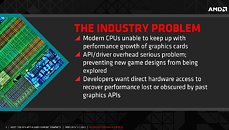
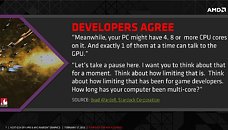
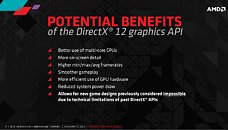
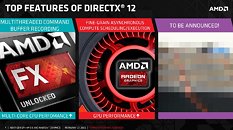
A graph from AMD on how a DirectX 11 app spreads CPU load across an 8-core CPU reveals how badly optimized the API is, for today's CPUs. The API and driver code is executed almost entirely on one core, and this is something that's bad for even dual- and quad-core CPUs (if you fundamentally disagree with AMD's "more cores" strategy). Overloading fewer cores with more API and driver-related serial workload makes up the "high API overhead" issue that AMD believes is holding back PC graphics efficiency compared to consoles, and it has a direct and significant impact on frame-rates.
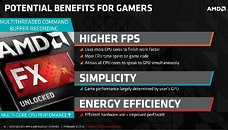
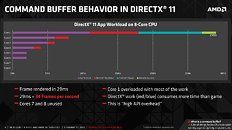

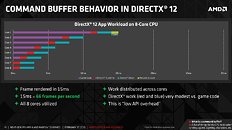

DirectX 12 heralds a truly multi-threaded command buffer pathway, which scales up with any number of CPU cores you throw at it. Driver and API workloads are split evenly between CPU cores, significantly reducing API overhead, resulting in huge frame-rate increases. How big that increase is in the real-world, remains to be seen. AMD's own Mantle API addresses this exact issue with DirectX 11, and offers a CPU-efficient way of rendering. Its performance-yields are significant on GPU-limited scenarios such as APUs, but on bigger setups (eg: high-end R9 290 series graphics, high resolutions), the performance gains though significant, are not mind-blowing. In some scenarios, Mantle offered the difference between "slideshow" and "playable." Cynics have to give DirectX 12 the benefit of the doubt. It could end up doing a better job than even Mantle, at pushing paper through multi-core CPUs.
AMD's own presentation appears to agree with the way Mantle played out in the real world (benefits for APUs vs. high-end GPUs). A slide highlights how DirectX 12 and its new multi-core efficiency could step up draw-call capacity of an A10-7850K by over 450 percent. Sufficed to say, DirectX 12 will be a boon for smaller, cheaper mid-range GPUs, and make PC gaming more attractive for the gamer crowd at large. The fine-grain asynchronous compute-scheduling/execution, is another feature to look out for. It breaks down complex serial workloads into smaller, parallel tasks. It will also ensure that unused GPU resources are put to work on these smaller parallel tasks.
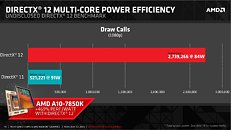
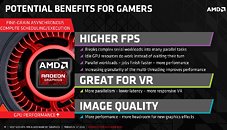
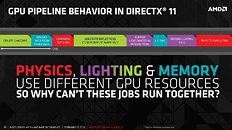
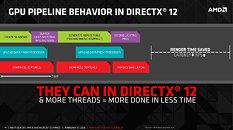
So where does AMD fit in all of this? DirectX 12 support will no doubt help AMD sell GPUs. Like NVIDIA, AMD has preemptively announced DirectX 12 API support on all its GPUs based on the Graphics CoreNext architecture (Radeon HD 7000 series and above). AMD's real takeaway from DirectX 12 will be how its cheap 8-core socket AM3+ CPUs could gain tons of value overnight. The notion that "games don't use >4 CPU cores" will dramatically change. Any DirectX 12 game will split its command buffer and API loads between any number of CPU cores you throw at it. AMD sells you 8-core CPUs for as low as $170 (the FX-8320). Intel's design strategy of placing stronger but fewer cores on its client processors, could face its biggest challenge with DirectX 12.
View at TechPowerUp Main Site
In its presentation, AMD touched upon two key features of the DirectX 12, starting with its most important, Multi-threaded command buffer recording; and Asynchronous compute scheduling/execution. A command buffer is a list of tasks for the CPU to execute, when drawing a 3D scene. There are some elements of 3D graphics that are still better suited for serial processing, and no single SIMD unit from any GPU architecture has managed to gain performance throughput parity with a modern CPU core. DirectX 11 and its predecessors are still largely single-threaded on the CPU, in the way it schedules command buffer.




A graph from AMD on how a DirectX 11 app spreads CPU load across an 8-core CPU reveals how badly optimized the API is, for today's CPUs. The API and driver code is executed almost entirely on one core, and this is something that's bad for even dual- and quad-core CPUs (if you fundamentally disagree with AMD's "more cores" strategy). Overloading fewer cores with more API and driver-related serial workload makes up the "high API overhead" issue that AMD believes is holding back PC graphics efficiency compared to consoles, and it has a direct and significant impact on frame-rates.





DirectX 12 heralds a truly multi-threaded command buffer pathway, which scales up with any number of CPU cores you throw at it. Driver and API workloads are split evenly between CPU cores, significantly reducing API overhead, resulting in huge frame-rate increases. How big that increase is in the real-world, remains to be seen. AMD's own Mantle API addresses this exact issue with DirectX 11, and offers a CPU-efficient way of rendering. Its performance-yields are significant on GPU-limited scenarios such as APUs, but on bigger setups (eg: high-end R9 290 series graphics, high resolutions), the performance gains though significant, are not mind-blowing. In some scenarios, Mantle offered the difference between "slideshow" and "playable." Cynics have to give DirectX 12 the benefit of the doubt. It could end up doing a better job than even Mantle, at pushing paper through multi-core CPUs.
AMD's own presentation appears to agree with the way Mantle played out in the real world (benefits for APUs vs. high-end GPUs). A slide highlights how DirectX 12 and its new multi-core efficiency could step up draw-call capacity of an A10-7850K by over 450 percent. Sufficed to say, DirectX 12 will be a boon for smaller, cheaper mid-range GPUs, and make PC gaming more attractive for the gamer crowd at large. The fine-grain asynchronous compute-scheduling/execution, is another feature to look out for. It breaks down complex serial workloads into smaller, parallel tasks. It will also ensure that unused GPU resources are put to work on these smaller parallel tasks.




So where does AMD fit in all of this? DirectX 12 support will no doubt help AMD sell GPUs. Like NVIDIA, AMD has preemptively announced DirectX 12 API support on all its GPUs based on the Graphics CoreNext architecture (Radeon HD 7000 series and above). AMD's real takeaway from DirectX 12 will be how its cheap 8-core socket AM3+ CPUs could gain tons of value overnight. The notion that "games don't use >4 CPU cores" will dramatically change. Any DirectX 12 game will split its command buffer and API loads between any number of CPU cores you throw at it. AMD sells you 8-core CPUs for as low as $170 (the FX-8320). Intel's design strategy of placing stronger but fewer cores on its client processors, could face its biggest challenge with DirectX 12.
View at TechPowerUp Main Site




 The ultimate Illuminati conspiracy
The ultimate Illuminati conspiracy 



